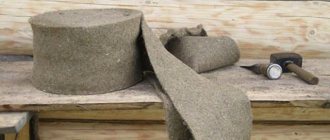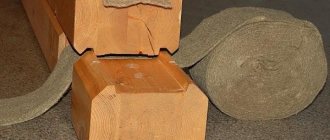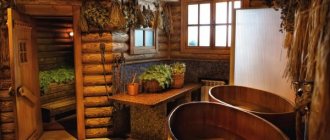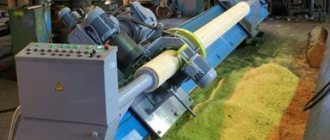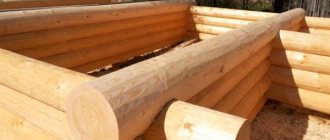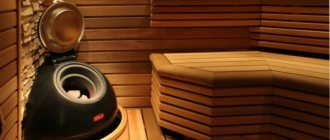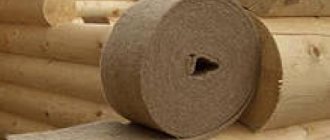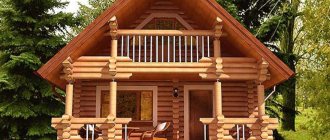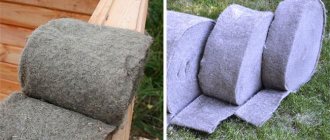Insulation of a bathhouse between the crowns refers to external thermal insulation, internal insulation of a bathhouse: floor, walls, ceiling, attic floor (if there is one) and roof - a separate article is devoted. And this is very important for a log bathhouse, since such bathhouses, as a rule, are not insulated from the inside. The choice of material is quite difficult: there are a huge number of different products of both natural and artificial origin.
Therefore, in search of an answer to the question: “which inter-crown insulation is better for a bathhouse?” many spend a lot of time and effort.
Interventional insulation for a bathhouse: which one to choose?
As already mentioned, all insulation materials can be divided into two large groups:
- Thermal insulation based on natural materials;
- Synthetic insulating materials.
Natural
In general, we can say that natural materials have the undoubted advantage of being environmentally friendly, but at the same time they are very labor-intensive to install and are more susceptible to rot and parasites. They have also long been used for insulating baths and other buildings. The price of these materials is also attractive. Synthetic insulation is more versatile and easier to use.
Insulation materials made from natural plant fibers include:
- jute (including jute tow and jute felt);
- linen;
- combined options : flax wool and flax jute;
- moss (as the most traditional insulation for a log bathhouse).
Reference. Natural insulation also includes clay and its mixtures, which are often used for thermal insulation of ceilings, not roofs.
Jute
It is a very popular material that is produced in small rolls of tape. Its thickness ranges from 5 to 15 mm. It is characterized by high density and uniformity. This is especially evident after complete installation: the jute adheres even more, becoming resistant to moisture and wind. It is quite easy to install; you need to roll out the roll to the desired length and secure it (for example, with a construction stapler).
Linen
Linen is inferior to jute in ease of use, but is also in demand. It is believed that due to its ability to accept and release moisture, it allows the structure to “breathe”. It is softer and easier to take the required shape.
It is a hypoallergenic substance and has disinfectant properties.
Combined options: flax wool and flax jute
When choosing combined materials, focus on the ratio of the amount of jute and flax in them. Depending on this, the material will have to a greater extent one or another of the above-described pros and cons. But, of course, combined materials can be called a good choice, since they will be more versatile and remain affordable for any budget.
Useful video
Look at the difference between jute and linen, according to an expert:
Moss (red moss, sphagnum, cuckoo flax)
It is a very common and traditional material that you can prepare yourself or purchase at a bargain price. It has bactericidal properties, but has a large number of disadvantages.
Negative features include:
- predisposition to drying out and spontaneous loss;
- the complexity of the caulking process;
- susceptible to destruction by insects and being pulled out by birds.
Based on sheep wool
A separate category is heat-insulating material based on sheep wool.
Most often used in the construction of baths from profiled timber. It plays the role of insulation, moisture and wind protection. This is possible due to the ability of wool, like wood, to regulate humidity. Another undoubted advantage is its durability: over time it does not lose its original volume.
Synthetic
Synthetic insulation materials include:
- thermal insulation tapes;
- combined materials.
The last two types appeared on the Russian market relatively recently. Tape material is attractive because it saves time on installation. This in turn significantly reduces the time required to build a bathhouse. Simultaneously with insulation, the tapes are able to remove moisture and play the role of wind protection. They are safe and hypoallergenic.
They are presented in a wide range depending on the parameters:
- — density (from 300 to 800 g per sq. m);
- — width (from 100 to 200 mm);
- — quantity (rolls from 10 to 50 lm).
Linen
Flax is a plant growing in Russia, Belarus, and Europe. Linen is very durable, has heat-saving, heat-transfer, and antiseptic properties. Linen fiber is used to produce fabrics that are used in various branches of light industry. Insulation (flax wool and tow) is made from flax. Ligin in flax is only 7% , which makes it unstable to the conditions of our climate. Rolled insulation – flax wool – is used as insulation in wooden houses and bathhouses. This is a special material for inter-crown gaskets. Linen is the most unstable insulation material. The service life of flax fiber is 1-3 years . It quickly rots when moisture gets on it and quickly disintegrates. Birds and rodents love this material.
It is loved by bedbugs, moths and many other insects. In view of this, it is necessary to antisepticize wood and all lumber. The roof extension in buildings where flax was used as insulation must be at least a meter. The main advantage of this material is environmental safety and excellent thermal conductivity.
Flax fiber insulation has proven itself to be excellent when caulking seams between logs, filling gaps when installing windows, doors, and insulating roofs, floors and ceiling surfaces. Linen is an excellent soundproofing material.
Insulation for a log bathhouse or for timber
For a log, a thicker layer of insulation (especially strip material) is taken, and for a bathhouse made of timber, a thickness of 8-10 mm is sufficient. If you use laminated veneer lumber, you can get by with a thickness of 5 mm. IMPORTANT! If there are gaps or other irregularities in the timber, the insulation is placed in two layers.
Materials based on plant fibers are perfect for logs, and roll products are ideal for timber.
It is advisable to complete the insulation of a bathhouse made of timber with finishing materials: clapboard, siding or block house. We recommend treating wooden finishing materials with special impregnations or oils.
It should be remembered that depending on the material from which the bathhouse is built, there are nuances of thermal insulation and recommendations regarding the materials used: insulation of walls made of wood, brick, blocks (especially foam concrete), frame walls requires special attention.
Useful video
Look at another professional’s opinion on the issue of “moss or jute”:
About quality
of inter-crown insulation materials currently present on the market , their quality should remain the main criterion. Only insulation products in the production of which natural fiber (be it flax or jute) were used, all quality parameters (density and uniformity of density) are met , thickness), only these will provide reliable protection of the inter-crown cavity.
I suggest buying jute in Minsk . The price is low. Also available:
Intercrown insulation, flax batting, tape tow, jute, jute rope, dowel, construction staples, tow, jute tape, heel, jute sealant, linen tape, rolled tow, jute rope.
Plant fibers or tape material
Plant fibers are often more affordable in terms of cost, but they require more installation time.
Plant fibers are more environmentally friendly, but have a shorter service life compared to synthetic materials.
Reference. A separate article is devoted to foil materials used as insulation for ceilings and walls.
What is it, when is it done and why?
A house or bathhouse made of logs shrinks in the first 2 years after construction. In the first year, the shrinkage of the log house reaches up to 20 cm. This factor should be taken into account when designing a house. This is due to loss of moisture and drying out.
During shrinkage, loose junctions appear in those places where everything was previously sealed. To eliminate this, resort to caulking. It is necessary to take measures to seal the cracks so that there is no heat loss or drafts. These activities are carried out only after the structure has settled.
Flaws
- The main disadvantage of burlap is its high flammability. There are special impregnations that increase fire-resistant properties, but the material remains flammable.
- In unfavorable conditions, natural fabrics are subject to the natural process of rotting.
- Nylon, lavsan and other types of synthetics have low hygroscopicity and are highly electrified.
- Polypropylene is waterproof, but this useful property has a downside: it does not allow air to pass through well. Manufacturing companies are working on this shortcoming. New items with ventilation inserts have appeared on sale.
On a note
Another modern trend is the production of eco-packaging. Natural components or polymers with biodegradable additives serve as raw materials for eco-bags. Their decomposition period varies from 1 month. up to 3 years.
Hard fiber burlap
The coarse and durable material is made from thick yarn in the same way as ordinary fabrics - by plain weave of threads. Fibers for yarn are of plant and artificial origin.
The raw materials for threads are:
- flax, hemp, jute;
- synthetic fibers - polyester, polypropylene, polyamide;
- mixed specimens combine plant bast and chemical components.
Note. Synthetic fabric is woven from flat threads. Natural material looks more textured, with a pronounced cellular structure.
Main characteristics
Density is considered the most important parameter of textile products. It determines how many warp and weft threads are located per 10 cm of material.
- Rough samples have low scores.
- For loose specimens - 26x25, for dense ones - 69x63.
- You can see with the naked eye how dense the technical canvas fabric is. A rare specimen has large cells resembling a spider's web.
- Samples with tight weave are more expensive. Fine-grained bulk substances are stored in such bags.
- The surface density of the fabric is calculated by weighing the sample. The indicator for natural options is 190-450 g/m2, for polypropylene - 48-200 g/m2.
- The width of the product varies between 95-110 cm for natural materials. The diameter of the polypropylene sleeve is 35–110 cm.
Upholstered furniture upholstered in Aegis fabric will take on an exclusive look. Along with the traditional jacquard fabric of this brand, you can purchase soft chenille upholstery fabric with an original pattern.
How to choose and care for fabric roller blinds? Answers to frequently asked questions are in this article.
